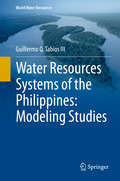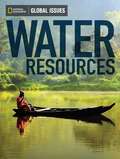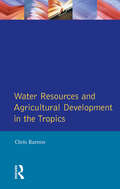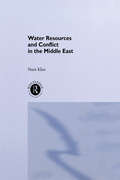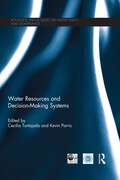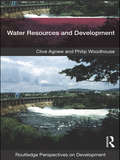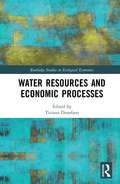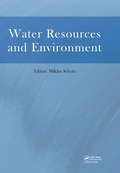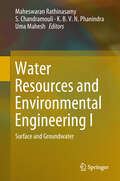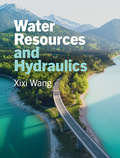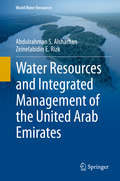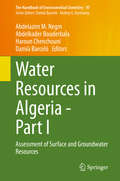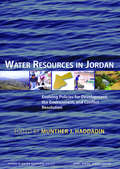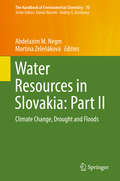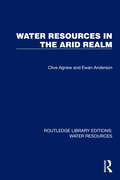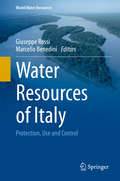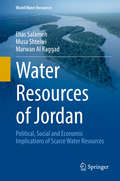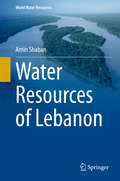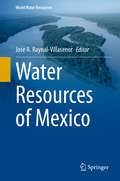- Table View
- List View
Water Resources Systems of the Philippines: Modeling Studies (World Water Resources #4)
by Guillermo Q. Tabios IIIThis book presents a number of modeling studies of various water resources systems in the humid tropics and the typical short, steep mountain-to-coast systems in the archipelagic setting of the Philippines. Covering natural and rural systems, urban watersheds and built systems, such as reservoirs and flood control systems, it discusses modeling studies based on pure simulation and combined optimization-simulation. The book offers insights into real-world water resources modeling, and as such is a valuable resource for academics and practitioners in the Philippines, as well as those in other Asian regions with similar water resources systems, and similar issues, problems and concerns.
Water Resources and Agricultural Development in the Tropics (Longman Development Studies)
by Christopher J. BarrowFirst published in 1988. There are many excellent texts on water supply and irrigation engineering, irrigation economics, agricultural development and the problems which often plague such efforts. Few syntheses of such writings have been made, despite a clear need for them from people interested in water resources and agricultural development: students of geography, economics, development studies and agricultural management, administrators, planners and aid agency staff. This book attempts to provide a broad interdisciplinary introduction for such people.
Water Resources and Conflict in the Middle East
by Nurit KliotThe Middle East is a region of international concern and political unrest. This book forms a complete reference to both the hydrological as well as the social, economic, political and legal issues in the region and shows how water shortages threaten the renewal of military conflicts and disruption in the area. With resources over-extended due to natural and human causes, the book analyses the river basins of the Euphrates, Tigris, Nile and Jordan and provides detailed study of the hydrology, hydrography and geography of these river basins; it also analyses the needs of the economies and societies of the countries bordering these basins. Conclusions on likely areas of conflict are set within the legal framework of the Helsinki and International Law Commission Rules.
Water Resources and Decision-Making Systems (Routledge Special Issues on Water Policy and Governance)
by Cecilia Tortajada Kevin ParrisWater data and information are essential to support efforts to understand, manage, allocate, utilize and protect water resources. The linkages between Water Information Systems and needs of decision makers are complex, but can be encapsulated in a Driving Force (Policy Needs) – Monitoring – Data Management – Reporting framework. The rapid development in water policy reforms in many sectors and growing emphasis on demand-side policy solutions to water resources management has created an information imbalance. This imbalance can be characterised in terms of an inverted pyramid with implementation of many water policy initiatives supported by little data and information, especially related to economic and financial elements, to help guide decision makers toward more effective and efficient water resources management strategies. Additionally, as stress and demands on water systems increase and water becomes a more valued resource, this tends to increase the value of water information both for water providers and users. Nevertheless, many countries are reporting that the capacity to collect water information is being undermined by a lack of resources, while expertise to collect, analyse and interpret water data for decision makers is being lost. Finally, the impact of climate change on hydrological regimes represents a key potential stress on water systems. This issue could be the catalyst for adapting policies to provide more efficient and effective use and management of water resources and advance institutional and governance reforms in the water sector.This book is based on a special issue of the International Journal of Water Resources Development.
Water Resources and Development
by Clive Agnew Philip WoodhouseSince the start of the twenty-first century there has been an unprecedented focus upon water as a key factor in the future of both society and environment. Water management lies at the heart of strategies of development as does the added the hazard of climate change. Water Resources and Development provides a stimulating interdisciplinary introduction to the role of water resources in shaping opportunities and constraints for development. The book begins by charting the evolution of approaches to water management. It identifies an emerging polarization in the late twentieth century between ‘technical’ and ‘social’ strategies. In the past decade these two axes of policy debate have been further intersected by discussion of the scale at which management decisions should be made: the relative effectiveness of ‘global’ and ‘local’ governance of water. A variety of case studies elaborate this analytical framework, exemplifying four key development challenges: economic growth, poverty reduction, competition and conflict over water, and adaptation to climate change. Current ‘best practice’ for water management is examined, addressing strategies of water supply augmentation, the ecological implications of intensified use, and strategies of demand management guided by economic or political principles. It is argued defining ‘successful’ water management and best practice requires first the establishment of development goals and the implicit trade-offs between water consumption and conservation. This engaging and insightful text offers a unique interdisciplinary analysis by integrating scientific, engineering, social and political perspectives. This is an essential text for courses on development studies, geography, earth sciences and the environment.
Water Resources and Economic Processes (Routledge Studies in Ecological Economics)
by Tiziano DistefanoWater exploitation has increased notably in the world during the last 250 years since the onset of industrialisation. The relationships between economic processes and water use are complex and include many interwoven drivers such as: technological development, dietary choices and food production, climate change, demographic change, and policy reforms, among others. Ensuring food, water, and energy for the growing population remains a common global challenge. Taking on a multi- and inter-disciplinary viewpoint, Water Resources and Economic Processes offers an up-to-date collection of contributions from leading scholars and works to gather research on important aspects of relevant fields and methodologies, including: Historical and long-term overview of the relations between income growth, water use, and technological development; Water markets and collaborative actions’ promise and threats in the fight against water stress; Impact of climate change on water productivity, including inter- and intra-annual variations; Urban reforms and surveys on the attitude of citizens towards private and public mitigation and preservation measures; Regional, national, and global comparative case-studies; International trade, migration, conf licts, and the globalisation of water; Methodological and empirical challenges of building future scenarios. This book is a key reference text for those studying water governance and management. It is suited to PhD students, national institutions, and NGO, as well as other professionals interested in understanding sustainable water use at the local, national, and international scales.
Water Resources and Environment: Proceedings of the 2015 International Conference on Water Resources and Environment (Beijing, 25-28 July 2015)
by Miklas ScholzThe 2015 International Conference on Water Resource and Environment (WRE2015) aims to provide a platform where scholars from different countries can exchange ideas, opinions and views. This book is divided into four main themes:1. Hydrology and water resources;2. Water pollution; 3. Water treatment methods, and4. Freshwater ecosystems. Exploring to
Water Resources and Environmental Engineering I: Surface And Groundwater
by S. Chandramouli Maheswaran Rathinasamy Uma Mahesh K.B.V.N. PhanindraThe book is a compilation of the papers presented in the International Conference on Emerging Trends in Water Resources and Environmental Engineering (ETWREE 2017). The high quality papers are written by research scholars and academicians of prestigious institutes across India. The book discusses the challenges of water management due to misuse or abuse of water resources and the ever mounting challenges on use, reuse and conservation of water. It also discusses issues of water resources such as water quantity, quality, management and planning for the benefits of water resource scientists, faculties, policy makers, stake holders working in the water resources planning and management. The research content discussed in the book will be helpful for engineers to solve practical day to day problems related to water and environmental engineering.
Water Resources and Hydraulics
by Xixi WangThis exciting new textbook introduces the concepts and tools essential for upper-level undergraduate study in water resources and hydraulics. Tailored specifically to fit the length of a typical one-semester course, it will prove a valuable resource to students in civil engineering, water resources engineering, and environmental engineering. It will also serve as a reference textbook for researchers, practicing water engineers, consultants, and managers. The book facilitates students' understanding of both hydrologic analysis and hydraulic design. Example problems are carefully selected and solved clearly in a step-by-step manner, allowing students to follow along and gain mastery of relevant principles and concepts. These examples are comparable in terms of difficulty level and content with the end-of-chapter student exercises, so students will become well equipped to handle relevant problems on their own. Physical phenomena are visualized in engaging photos, annotated equations, graphical illustrations, flowcharts, videos, and tables.
Water Resources and Integrated Management of the United Arab Emirates (World Water Resources #3)
by Abdulrahman S. Alsharhan Zeinelabidin E. RizkThis book provides an inventory of water resources, describes water challenges, and suggests methodologies and technologies for integrated water resources management in the UAE. It also summarizes efforts of water conservation and management, and modern approaches for improvement of water resources management and decision-making related to this valuable resource. The authors are specialized in geology and hydrogeology and have been teaching and conducting scientific research on water resources in the UAE for the last three decades. This book represents the main reference on water resources in the UAE for academia, researchers, professionals, students and the general public.
Water Resources in Algeria - Part I: Assessment of Surface and Groundwater Resources (The Handbook of Environmental Chemistry #97)
by Damià Barceló Abdelazim M. Negm Haroun Chenchouni Abdelkader BouderbalaThis book reviews the latest information on the assessment of surface and groundwater resources in Algeria. The authors cover a large diversity of topics, including the status and assessment of water resources, impacts of pesticides, soil droughts, analysis of flood characteristics, hydrogeological investigations and modeling applications, and evapotranspiration. Special attention is given to the impacts of climate changes on water resources. The assessment methods present in this book can be used or adapted to study other regions of North Africa, Middle East and/or in the Mediterranean with similar climate conditions as Algeria.This book and the companion volume Water Resources in Algeria - Part II: Water Quality, Treatment, Protection and Development will appeal to engineers, researchers, graduate students and policymakers interested in the field of groundwater and surface water assessment.
Water Resources in Algeria - Part II: Water Quality, Treatment, Protection and Development (The Handbook of Environmental Chemistry #98)
by Damià Barceló Abdelazim M. Negm Haroun Chenchouni Abdelkader BouderbalaThis book reviews the latest water quality protection and water resources development strategies in Algeria. It covers topics such as the assessment and prediction of water quality, salt-water intrusion, treatment of wastewater for reuse, and desalination as an alternative source of water. The methods presented in this book can also be applied in other regions with similar climate conditions. Together with the companion volume Water Resources in Algeria - Part I: Assessment of Surface and Groundwater Resources, this book provides researchers with essential reference material on tools and techniques for water quality assessment, treatment, reuse, desalination, protection, and development, and offers a valuable resource for engineers, graduate students and policymakers who are interested in sustainable water resources.
Water Resources in Arid Lands: Management and Sustainability (Advances in Science, Technology & Innovation)
by Osman Abdalla Anvar Kacimov Mingjie Chen Ali Al-Maktoumi Talal Al-Hosni Slim Zekri Kaveh MadaniThis book presents the most recent innovative studies in the field of water resources for arid areas to move towards more sustainable management of the resources. It gathers outstanding contributions presented at the 2nd International Water Conference on Water Resources in Arid Areas (IWC), which was held online (Muscat, Oman) in November 2020. Papers discuss challenges and solutions to alleviate water resource scarcity in arid areas, including water resources management, the introduction of modern irrigation systems, natural groundwater recharge, construction of dams for artificial recharge, use of treated wastewater, and desalination technologies. As such, the book provides a platform for the exchange of recent advances in water resources research, which are essential to improving the critical water situation and to move towards more sustainable management of water resources.
Water Resources in Jordan: Evolving Policies for Development, the Environment, and Conflict Resolution
by Munther J. HaddadinThis is the first comprehensive, multi-disciplinary book to address water policy in Jordan. Edited by the former Minister of Water and Irrigation of Jordan, with contributions by other prominent Jordanian and international water professionals, this volume covers such areas as the population-water resources equation in Jordan; institutional and legal frameworks; the data systems used for the assessment and formulation of water policy; water allocations and uses in municipal, industrial, and agricultural sectors; social and environmental issues; and water conflict with Jordan's neighbors. The book is a must for readers interested in Middle East politics and the critical nature of water issues in the region. The book notes the importance of interaction with the outside world to augment water resources through trade, making the experience of Jordan relevant to other developing regions where water is scarce. It introduces the term 'shadow water' to mean the scarce indigenous water resources that the import of agricultural and industrial commodities saves or replaces. The book shows how financially profitable it can be to treat water as a tradable commodity, to be exchanged peaceably across international borders. Haddadin and his distinguished contributors bring the water conflicts between Jordan and its neighbors, Israel and Syria, into sharp focus. The book includes a historical perspective on the development of water policies in Jordan and explores the significance of water in the religious, social, and political life of the country.
Water Resources in Slovakia: Assessment And Development (The Handbook of Environmental Chemistry #69)
by Martina Zeleňáková Abdelazim M. NegmThis volume presents up-to-date information on the status and assessment of water resources in Slovakia and methods for their development. The major themes include key facts about Slovakian water resources, their assessment and development; water supply and demand; irrigation water; groundwater; water and sediment quality with a focus on mining water; wastewater management in Slovakia; and rainwater management. The book closes with general conclusions and recommendations for future research. It is a valuable resource for graduate students and researchers as well as for decision makers involved in sustainable development.
Water Resources in Slovakia: Climate Change, Drought And Floods (The Handbook of Environmental Chemistry #70)
by Martina Zeleňáková Abdelazim M. NegmThis book offers up-to-date information on the impact of climate change on water resources in Slovakia, the occurrence of drought and floods, hazards and protection methods. The topics covered include hydrological extremes, such as droughts and flood, in Slovakia; risk assessment and protection; sustainable management; and water management in buildings. The closing chapter provides general conclusions and recommendations for future research. It appeals to graduate students and researchers as well as to decision makers involved in planning future water resources in Slovakia.
Water Resources in the Arid Realm (Routledge Library Editions: Water Resources)
by Ewan Anderson Clive AgnewOriginally published in 1992, this book dispels some of the myths that surround water resource problems of arid lands and the notion that there are simple ‘once and for all’ solutions. Population growth, industrialization, environmental mismanagement and land degradation have led to droughts, poverty and famine with the result that the need for space, food and key natural resources such as water has become the most critical issue in global development. Nowhere is this crisis more apparent than in arid lands, where water resources provide the key to economic and environmental development. The authors argue that as the arid land environment is highly variable the key to success is flexibility. The book is divided into four sections, dealing with the geography of the arid realm; the water resource problems they face: the methods available for enhancing water supplies and finally, management of this resource. The book will be of use to undergraduate and postgraduate student and for those actively engaged in the development of arid land water resources.
Water Resources in the Lancang-Mekong River Basin: Impact of Climate Change and Human Interventions
by Qiuhong Tang Deliang Chen Junguo LiuThis open access book provides a comprehensive, up-to-date picture of the current state of knowledge covering climate change, surface water change, arsenic pollution, water utilization, water-food-energy nexus, water related hazards, water management, and water governance in the Lancang-Mekong River Basin. Considering the widely concerned fact that the climate change and human intervention induced impacts on water will bring unprecedented threats to human societies and ecosystems, the book intends to support UN’s sustainable development goals through sustainable use of water by providing the most accurate and updated information on climate and water changes in a consistent way. Underlying all aspects of the book is a strong commitment to assessing the science comprehensively, without bias and in a way that is relevant to policy but not policy prescriptive. It can provide implications to support decision-makers and stakeholders for integrated water resources management and sustainable development at all levels.
Water Resources of Chile (World Water Resources #8)
by Bonifacio Fernández Jorge GironásChile is a privileged country in terms of water resources, with an average annual runoff of approximately 50,000 m3/person. However, water availability varies enormously in space, as less than 1,000 m3/person are available for more than 50% of the population. The temporal and spatial distribution of water resources is driven by processes highly variables across a country with different climates explained not only by a large range of latitudes (from 17° to 56° south), but also the presence of the Pacific Ocean and the Andes with peaks up to 7000 m. This geography makes of Chile a true natural laboratory in which water is essential for the society and the economy of the country. The relevance of water resources for the country has become even more significant in the context of a mega-drought that has affected practically the entire territory in recent years, although large floods such as those in Atacama 2015 and 2017 also take place periodically. This unique book brings together the state-of-art knowledge about the hydrology of Chile and its water resources, with a particular focus on quantitative aspects. The chapters are prepared by many of the most relevant researchers and practitioners working in water resources in the country. High-quality research contributions on climate and meteorology, surface and subsurface hydrology, water quality, water monitoring, water resource and global change, among other issues, are presented in this unique book, which offers a useful guide for academicians, researchers, practitioners and managers dealing with diverse water-related issues in Chile and other regions with similar characteristics
Water Resources of Italy: Protection, Use and Control (World Water Resources #5)
by Marcello Benedini Giuseppe RossiThis book offers a comprehensive framework of the current state of water resources in Italy and of the main stages of the evolutionary way in the last decades for achieving an integrated, sustainable and equitable water resources management. The main paradigms of water resources development are identified as: i) engineering and economic approach to water resources exploitation, ii) focus on pollution control and water-excess management, iii) a comprehensive approach toward a sustainable and equitable distribution of resources and effective risk reduction of water-related disasters. After a section devoted to the analysis of some historic stages in the legislation framework and the governance of water and soil, with particular reference to planning, design, building and operation of water systems, two sections deal with the estimation of water resources availability on national territory and estimation of water demands in municipal, agricultural, industrial, ecosystem sectors. The complex problems that the Italian society has to solve in the water field and the main challenges of a changing world are discussed in the fourth section of the volume. The book will not only be useful for water professionals, but also for citizen who like to discern the key factors which delay the recognition of water as a resource for life. The description of the problems and adopted solutions could also serve as a guideline for similar situations encountered in other countries, improving the preparation of the responsible people.
Water Resources of Jordan: Political, Social And Economic Implications Of Scarce Water Resources (World Water Resources #1)
by Elias Salameh Musa Shteiwi Marwan Al RaggadThis book gives a detailed account of the scarce water resources of Jordan, with a focus on their quantities, quality, and use for different sectors. It details the political, social, and economic dimensions of the scarce water resources along with their implications on Jordan's cooperation with its neighbors. The book includes implemented projects of dams, canals, water supply networks, waste water treatment, and more. It gives an overview of which projects have been successful and which have failed to achieve their purposes and why. Shared water with other countries and their developmental implications to the water sector are discussed and future water supply projects, such as the Red Sea-Dead Sea conduit project, are elaborated on. The book also touches upon the waves of refugees and their impact on the water sector and water strategies in Jordan.
Water Resources of Lebanon (World Water Resources #7)
by Amin ShabanWater has become a challenging resource that many countries worldwide are concerned with. Thus, water is often linked with health, society development, national income and even international geo-politics. Sometimes, water resources are unavailable, but successful management involves developing approaches and projects to assure water supply. However, there are some countries with available water resources, but unsatisfactory management, and thus complain about water supply becoming a national problem. This situation is prevalent in Lebanon, a country characterized by abundant water resources whether on the surface or sub-surface. It is a paradox that there is still imbalance in water supply/demand in Lebanon, and water resources are now under stress due to chaotic use. This has been exacerbated by the oscillating climatic conditions, increased population and improper management. Therefore, people receive less than one-third of their water needs, and most water supplied is of poor quality. The current status shows a descending trend. Undoubtedly, if the water sector in Lebanon continues this way, we should anticipate unfavourable (and may be severe) consequences. Many studies have been conducted on water and related disciplines in Lebanon; however, all of them focus on specific themes and sometimes defined regions. Nevertheless, the occurred changes on the influencers (natural and man-made) have not been considered. This book is the first of its type for Lebanon, and it shows all aspects of water resources with updated measurements and findings obtained by adopting new techniques. It diagnoses in-depth the major elements of water flow/storage mechanism that have never been covered in such a comprehensive manner before. Also, this book introduces and analyses the existing challenges and proposes solutions. It represents a comprehensive investigation of the water resources in Lebanon.
Water Resources of Libya: Challenges and Management (Springer Water)
by Hamdi A. ZurqaniThis book addresses a range of water resources management issues, especially those that are relevant to the water quality in Libya. It covers topics such as the assessment and prediction of water quality, salt-water intrusion, treatment of wastewater for reuse, and desalination as an alternative source of water. It provides up-to-date information on the impact of climate change on water resources in Libya and summarize the latest results of several systematic investigations and assesses the occurrence and quality of surface and underground waters in the country to help decision-makers plan for sustainable development. The methods presented in this book can also be applied in other regions with similar climate conditions. This book will share the knowledge and experience of experts and scientists who apply high-quality findings and input from their research to issues concerning the management of water resources and their quality in Libya.
Water Resources of Mexico (World Water Resources #6)
by Jose A. Raynal-VillasenorThis comprehensive volume presents the topic of water resources of Mexico from a different angle. Besides covering the geohydrology it also offers a brief account of the ancient water resources works, explains from where the water is coming, how the water is being used in homes and in the industry, how the dams are operated in the hurricane season, some aspects of the water-energy-food securities nexus and the expectations for the future in connection with global climate change. The book is of interest to every one connected with the water resources of Mexico, e.g. federal and state employees of agencies related with water management, water supply and wastewater treatment. It is also of value to those in academia and employed at water related professional associations and the general public.
